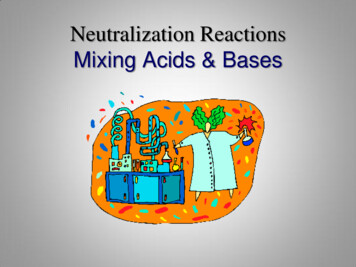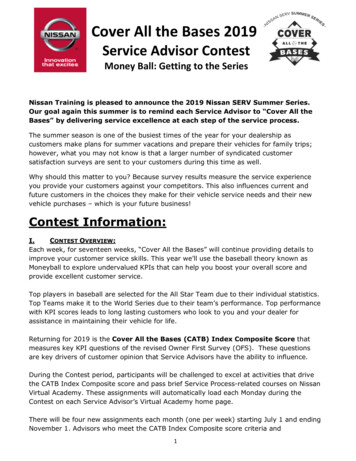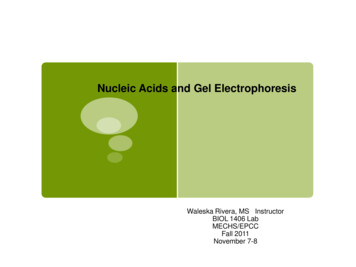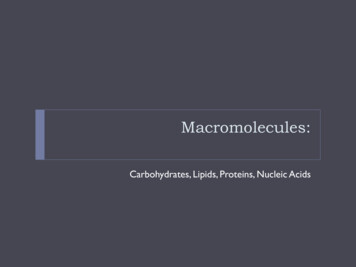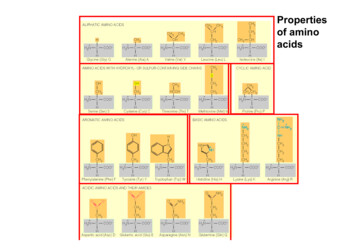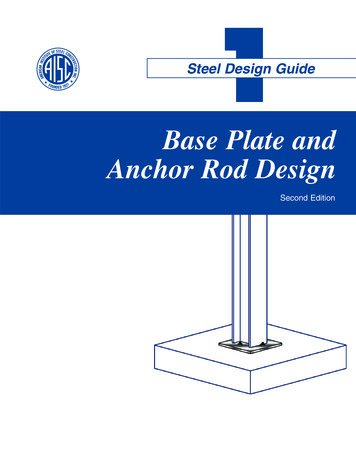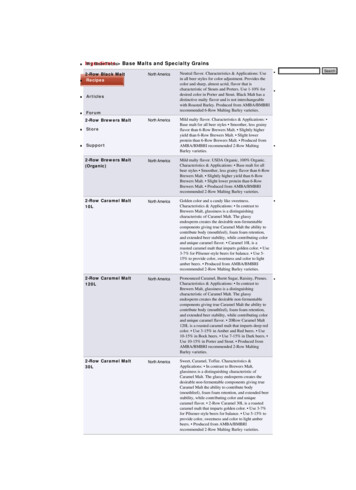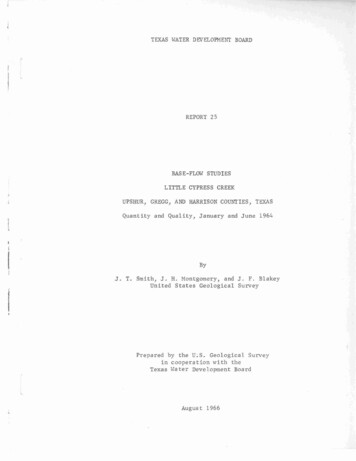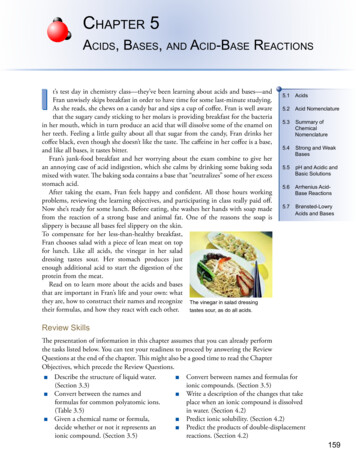
Transcription
Chapter 5Acids, Bases, and Acid-Base Reactionst’s test day in chemistry class—they’ve been learning about acids and bases—andFran unwisely skips breakfast in order to have time for some last‑minute studying.As she reads, she chews on a candy bar and sips a cup of coffee. Fran is well awarethat the sugary candy sticking to her molars is providing breakfast for the bacteriain her mouth, which in turn produce an acid that will dissolve some of the enamel onher teeth. Feeling a little guilty about all that sugar from the candy, Fran drinks hercoffee black, even though she doesn’t like the taste. The caffeine in her coffee is a base,and like all bases, it tastes bitter.Fran’s junk-food breakfast and her worrying about the exam combine to give heran annoying case of acid indigestion, which she calms by drinking some baking sodamixed with water. The baking soda contains a base that “neutralizes” some of her excessstomach acid.After taking the exam, Fran feels happy and confident. All those hours workingproblems, reviewing the learning objectives, and participating in class really paid off.Now she’s ready for some lunch. Before eating, she washes her hands with soap madefrom the reaction of a strong base and animal fat. One of the reasons the soap isslippery is because all bases feel slippery on the skin.To compensate for her less‑than‑healthy breakfast,Fran chooses salad with a piece of lean meat on topfor lunch. Like all acids, the vinegar in her saladdressing tastes sour. Her stomach produces justenough additional acid to start the digestion of theprotein from the meat.Read on to learn more about the acids and basesthat are important in Fran’s life and your own: whatthey are, how to construct their names and recognize The vinegar in salad dressingtheir formulas, and how they react with each other. tastes sour, as do all acids.5.1Acids5.2Acid Nomenclature5.3Summary ofChemicalNomenclature5.4Strong and WeakBases5.5pH and Acidic andBasic Solutions5.6Arrhenius AcidBase Reactions5.7Brønsted-LowryAcids and BasesReview SkillsThe presentation of information in this chapter assumes that you can already performthe tasks listed below. You can test your readiness to proceed by answering the ReviewQuestions at the end of the chapter. This might also be a good time to read the ChapterObjectives, which precede the Review Questions.Describe the structure of liquid water.Convert between names and formulas for(Section 3.3)ionic compounds. (Section 3.5)Convert between the names andWrite a description of the changes that takeformulas for common polyatomic ions.place when an ionic compound is dissolved(Table 3.5)in water. (Section 4.2)Given a chemical name or formula,Predict ionic solubility. (Section 4.2)decide whether or not it represents anPredict the products of double‑displacementionic compound. (Section 3.5)reactions. (Section 4.2)159
160Chapter 5Acids, Bases, and Acid-Base Reactions5.1 AcidsAcids have many uses. For example, phosphoric acid is used to make gasoline additivesand carbonated beverages. The textile industry uses oxalic acid (found in rhubarb andspinach) to bleach cloth, and glass is etched by hydrofluoric acid. Dyes and manyother chemicals are made with sulfuric acid and nitric acid, and corn syrup, which isadded to a variety of foods, is processed with hydrochloricacid. The chemical reactions of acids often take place inwater solutions, so after discussing what acids are, we willexplore a model for visualizing the particle structure ofwater solutions of acids.Arrhenius AcidsYou may have already noticed, in your first few weeks ofstudying chemistry, that the more you learn about matter,the more ways you have of grouping and classifying thedifferent substances. The most common and familiar wayof classifying substances is by their noteworthy properties.Acids have many uses, including making car batteries,For example, people long ago decided that any substancesoftdrinks, artificial sweeteners, and napkins.that has a sour taste is an acid. Lemons are sour becauseObjective 2they contain citric acid, and old wine that has been exposed to the air tastes sour due toacetic acid. As chemists learned more about these substances, however, they developedmore specific definitions that allowed classification without relying on taste. A goodthing, too, because many acids and bases should not be tasted—or even touched. Theyspeed the breakdown of some of the substances that form the structure of our bodiesor that help regulate the body’s chemical changes.Two different definitions of acid are going to be of use to us. For example, chemistsconduct many laboratory experiments using a reagent known as “nitric acid,” asubstance that has been classified as an acid according to the Arrhenius definition ofacid (named after the Swedish Nobel prize-winning chemist, Svante August Arrhenius).Arrhenius recognized that when ionic compounds dissolve, they form ions in solution.(Thus, when sodium chloride dissolves, it forms sodium ions and chloride ions.) Hepostulated that acids dissolve in a similar way to form H ions and some kind ofanion. For example, he predicted that when HCl is added to water, H ions and Cl ions form. We now know that H ions do not persist in water; they combine withwater molecules to form hydronium ions, H3O . Therefore, according to the modernform of the Arrhenius theory, an acid is a substance that produces hydronium ions,H3O , when it is added to water. On the basis of this definition, an acidic solutionis a solution with a significant concentration of H3O . For reasons that are describedin Section 5.7, chemists often find this definition too limiting, so another, broaderdefinition of acids, called the Brønsted‑Lowry definition, which we describe later, iscommonly used instead.Objective 3To get an understanding of how hydronium ions are formed when Arrheniusacids are added to water, let’s consider the dissolving of gaseous hydrogen chloride,HCl( g), in water. The solution that forms is called hydrochloric acid. When HClmolecules dissolve in water, a chemical change takes place in which water molecules
5.1 Acids161pull hydrogen atoms away from HCl molecules. In each case, the hydrogen atom istransferred without its electron, that is, as an H ion, and because most unchargedhydrogen atoms contain only one proton and one electron, most hydrogen atomswithout their electrons are just protons. For this reason, the hydrogen ion, H , isoften called a proton. We say that the HCl donates a proton, H , to water, forminghydronium ion, H3O , and chloride ion, Cl- (Figure 5.1).Figure 5.1HCl Reactionwith WaterThis proton, H , is transferred to a water molecule. HCl( g) H2O(l ) Cl (aq) H3O (aq)Because HCl produces hydronium ions when added to water, it is an acid accordingto the Arrhenius definition of acids. Once the chloride ion and the hydronium ionare formed, the negatively charged oxygen atoms of the water molecules surround thehydronium ion, and the positively charged hydrogen atoms of the water moleculessurround the chloride ion. Figure 5.2 shows how you can picture this solution.Hydronium ions, H3O ,surrounded by thenegatively chargedoxygen ends of water molecules.- - - -Chloride ions, Cl ,surrounded by thepositively chargedhydrogen ends ofwater molecules.- - -- -- 500400300200100 Objective 3- -Objective 3Figure 5.2Hydrochloric Acid in WaterHydrochloric acid solutions are used in the chemical industry to remove impuritiesfrom metal surfaces (this is called pickling), to process food, to increase thepermeability of limestone (an aid in oil drilling), and to make many importantchemicals.
162Chapter 5Acids, Bases, and Acid-Base ReactionsTypes of Arrhenius AcidsIn terms of chemical structure, Arrhenius acids can be divided into several differentsubcategories. We will look at three of them here: binary acids, oxyacids, and organicacids. The binary acids are HF(aq), HCl(aq), HBr(aq), and HI(aq); all have thegeneral formula of HX(aq), where X is one of the first four halogens. The formulas forthe binary acids will be followed by (aq) in this text to show that they are dissolved inwater. The most common binary acid is hydrochloric acid, HCl(aq).Oxyacids (often called oxoacids) are molecular substances that have the generalformula HaXbOc. In other words, they contain hydrogen, oxygen, and one otherelement represented by X; the a, b, and c represent subscripts. The most commonoxyacids in the chemical laboratory are nitric acid, HNO3, and sulfuric acid, H2SO4.Acetic acid, the acid responsible for the properties of vinegar, contains hydrogen,oxygen, and carbon and therefore fits the criteria for classification as an oxyacid, but itis more commonly described as an organic (or carbon‑based) acid. It can also be calleda carboxylic acid. (This type of acid is described in more detail in Section 17.1.) Theformula for acetic acid can be written as either HC2H3O2, CH3CO2H, or CH3COOH.The reason for keeping one H in these formulas separate from the others is that thehydrogen atoms in acetic acid are not all equal. Only one of them can be transferredto a water molecule. That hydrogen atom is known as the acidic hydrogen. We will usethe formula HC2H3O2 because it is more consistent with the formulas for other acidspresented in this chapter. The Lewis structure, space‑filling model, and ball‑and‑stickmodel for acetic acid (Figure 5.3) show why CH3CO2H, and CH3COOH are alsocommon. The acidic hydrogen is the one connected to an oxygen atom.Objective 4Objective 5Figure 5.3Acetic AcidAcidichydrogenH OAcidichydrogenDouble bond,four electronsshared by atomsH C C O HHAcidichydrogenPure acetic acid freezes at 17 C (63 F). Therefore, it is a liquid at normal roomtemperature, but if you put it outside on a cold day, it will freeze. The solid has layeredcrystals that look like tiny glaciers, so pure acetic acid is called glacial acetic acid. Thechemical industry uses acetic acid to make several substances necessary for producinglatex paints, safety glass layers, photographic film, cigarette filters, magnetic tapes, andclothing. Acetic acid is also used to make esters, which are substances that have verypleasant odors and are added to candy and other foods.Acids can have more than one acidic hydrogen. If each molecule of an acid candonate one hydrogen ion, the acid is called a monoprotic acid. If each molecule candonate two or more hydrogen ions, the acid is a polyprotic acid. A diprotic acid, suchas sulfuric acid, H2SO4, has two acidic hydrogen atoms. Some acids, such as phosphoric
5.1 Acidsacid, H3PO4, are triprotic acids. Most of the phosphoric acidproduced by the chemical industry is used to make fertilizersand detergents, but it is also used to make pharmaceuticals, torefine sugar, and in water treatment. Thetartness of some foods and beveragescomes from acidifying them by adding Acidic hydrogen atomsphosphoric acid. The space-filling modelin Figure 5.4 shows the three acidichydrogen atoms of phosphoric acid.Figure 5.4The phosphate in thisfertilizer was made fromphosphoric acid.Strong and Weak AcidsAlthough hydrochloric acid and acetic acid are both acids according to the Arrheniusdefinition, the solutions created by dissolving the same numbers of HCl and HC2H3O2molecules in water have very different acid properties. You wouldn’t hesitate to put asolution of the weak acid HC2H3O2 (vinegar) on your salad, but putting a solutionof the strong acid HCl on your salad would have a very different effect on the lettuce.With hydrochloric acid, you are more likely to get a brown, fuming mess rather thana crisp, green salad. Strong acids form nearly one H3O ion in solution for each acidmolecule dissolved in water, whereas weak acids yield significantly less than one H3O ion in solution for each acid molecule dissolved in water.When an acetic acid molecule, HC2H3O2, collides with an H2O molecule, an H can be transferred to the water to form a hydronium ion, H3O , and an acetate ion,C2H3O2-. The acetate ion, however, is less stable in solution than the chloride ionformed when the strong acid HCl dissolves in water. Because of this instability, theC2H3O2- reacts with the hydronium ion, pulling the H ion back to reform HC2H3O2and H2O. A reaction in which the reactants are constantly forming products and, atthe same time, the products are re‑forming the reactants is called a reversible reaction.The chemical equations for reactions that are significantly reversible are written withdouble arrows as illustrated in Figure 5.5.Objective 6This proton, H , istransferred toa water molecule.HC2H3O2(aq) H2O(l )Objective 6Figure 5.5Reversible Reaction of Acetic Acid and WaterThis proton, H , maybe transferred backto the acetate ion.Indicates areversiblereaction 163 C2H3O2 (aq) If you were small enough to be riding on one of the carbon atoms in HC2H3O2or C2H3O2-, you would find that your atom was usually in the HC2H3O2 form butoften in the C2H3O2- form and continually changing back and forth. The forward andreverse reactions would be taking place simultaneously all around you. When acetic H3O (aq)Objective 6
164Chapter 5Acids, Bases, and Acid-Base Reactionsacid is added to water, the relative amounts of the different products and reactantssoon reach levels at which the opposing reactions proceed at equal rates. (We will seewhy in Chapter 16.) This means that the forward reaction is producing C2H3O2- asquickly as the reverse reaction is producing HC2H3O2(aq). At this point, there is nomore net change in the amounts of HC2H3O2, H2O, C2H3O2-, or H3O in thesolution. For example, for each 1000 molecules of acetic acid added to water, thesolution will eventually contain about 996 acetic acid molecules (HC2H3O2), fourhydronium ions (H3O ), and four acetate ions (C2H3O2-). Acetic acid is therefore aweak acid, a substance that is incompletely ionized in water because of the reversibilityof its reaction with water that forms hydronium ion, H3O . Figure 5.6 shows a sim
their formulas, and how they react with each other. 5.1 Acids 5.2 Acid Nomenclature 5.3 Summary of Chemical Nomenclature 5.4 Strong and Weak Bases 5.5 pH and Acidic and Basic Solutions 5.6 Arrhenius Acid-Base Reactions 5.7 Brønsted-Lowry Acids and Bases Review Skills The presentation of information in this chapter assumes that you can already perform the tasks listed below. You can test
